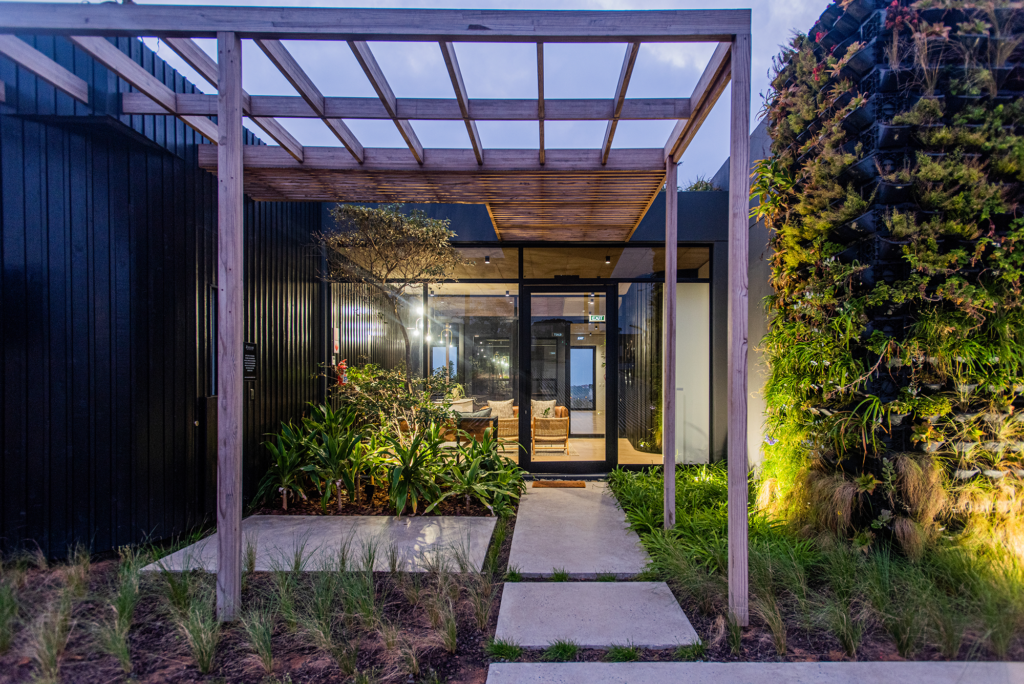Never has the need for a life close to nature been more pressing. With the stresses of modern life and a global pandemic forcing us to pause and appreciate our surroundings, many are finding calm and joy in spaces that draw them nearer to Mother Nature. At Zululami Luxury Coastal Estate, it’s always been our goal to do just that. In a recent article by The Green Times, Bernice Rumble from Land Art Studio explains our approach to biophilic design and shares why it’s making the earth and our people all the happier for it…
“Today’s architecture takes its cues from nature. And rightfully so. It’s the underlying ethos of many new North Coast residential estates where developers have rehabilitated land once used for sugar cane farming or now overcome with alien vegetation.
This architectural vision mimics natural shapes and forms, makes use of natural materials, and integrates design features that link the built environment to the natural one.
Awareness of the inestimable value of human-nature connectivity has been growing over the past few decades and ratcheted up during lockdown. Getting out there as seldom as we did, opened us up to nature’s role in our mental and physical well-being.
There is solid scientific proof that this connectivity promotes health, and the disconnect is the reverse…from the documented increase in productivity of those with an office or schoolroom with a natural outlook to the recovery rate or wellness in frail care/post-operative units with a natural aspect. Even retail achieves higher rentals in environments where greenery features strongly.
Bernice Rumble from Land Art Studio unpacked the concept of biophilic design:
“It’s used in the building industry, to increase the occupants’ connectivity to the natural environment through the use of direct nature, indirect nature, and space and place conditions.”
Its name may have been recently coined, but indicators of biophilic design have been seen in architecture as far back as the Hanging Gardens of Babylon.
“In a nutshell, biophilic design offers health, environmental and economic benefits for building occupants and urban environments, with few drawbacks,” says Bernice.
Biomimicry is another related concept. Translated as ‘looking to nature for knowledge’, it’s a driving force for most architects and designers today. Bernice describes it as, “a conscious decision in design. You use nature as a model, where natural forms inspire you – it’s a visual sensitivity to nature.”
But it goes beyond that. Think of how the mechanics of birds in flight inspired the design of an aeroplane. Nature has lessons.
“Nature runs on sunlight,” explains Bernice.
“It only uses the energy it needs. It always fits form to function, recycles everything, rewards cooperation, banks on diversity, demands local expertise, and curbs excess from within. Nature is able to balance itself. We’ve lost that balance, and we need to regain it.”
Clearly, if you’re designing and building from scratch, it’s easier to orchestrate. These glorious new eco estates focus on rehabilitation and sustainable living – their designs are based on the premise that nature promotes wellness and health. And it’s not simply about including cycling trails and outdoor gyms. Nature itself is the healer, so it’s about making that connection when you’re cycling, and equally, when you’re at work or at home.
“As landscape architects, one of our leading principles is to breathe vitality into the spaces that we design. We design for vitality.”
Zululami Luxury Coastal Estate on the KZN north coast is a prime example of biophilic design, right from the gatehouse, designed by architect Lisa Rorich. No longer does an estate of this stature concern itself with architecture that makes a loud ‘Look At Me’ statement – it’s quite the opposite.
The more subtle the building, the more unobtrusive, the more visually pleasing:
“This building is ‘broken up’, so it’s not one heavy mass,” says Bernice. “There’s an inner courtyard, too, so it’s possible to ‘work’ outdoors.”
Orientation matters. Whether for people or plants, the building’s orientation is a major consideration.
“Making use of natural light is important, not only because it promotes wellness, but by maximising daylight, electric light usage is minimised. Natural ventilation is just as important – far better air quality than air-conditioning.”
She added, “If we could apply these principles everywhere, we’d eradicate sick building syndrome.”
The Zululami gatehouse has a lush green growing wall, and an exquisite roof garden with plants trickling down softly into the courtyard. Installation of these should always be done by specialists, as their knowledge and expertise matters, in particular, the roof garden, because of the required irrigation/waterproofing. There are various DIY green wall fittings on the market today, and if you’d like to try, do start small. It needs extensive homework and, ideally, a really handy man.
The gatehouse is also constructed of wonderfully raw, natural, locally sourced materials, which play a major role in integrating spaces with nature.
“When inside the building, there’s a constant visual contact to the outside,” says Lisa, “ reaffirming that human-nature connection.”
What do you need to begin your reconnect with nature?
“A change of consciousness and a different approach,” says Bernice.
Simply including indoor plants is a good, effective start, and although trends are not the issue here, plants are increasingly considered an integral part of good-looking, alive décor.
“Once the realisation and acceptance lands that nature has a health benefit, it’s relatively easy from there. Just start small.
“There are so many ways to begin. It could be a decision to create a collection of staghorn ferns on a timber screen, or orchids on a tree. You could decide to give over a quarter of your lawn to plantings which attract birds, bees and butterflies,” suggests Bernice.
But start with a quick analysis of exactly where you live – does your property fall into the category of coastal grassland or coastal forest? It’s important to plant trees and shrubs endemic to your region. All plant choices must consider Aspect (sun/shade), wind, salt air, root conditions and seasonal changes – a great indigenous nursery or landscaper will help get you there.
As Bernice says, “We are so fortunate to live in a sub-tropical region, where we have a vast plant palette at our disposal – our plant choices allow variation in form, texture, colour and size.”
With the endless reference sites on the internet available to us all, it’s straightforward to get going. And get your children involved. Do a little homework – it’s so worthwhile. Apart from the soft visual pleasure, there’s something so satisfying when those birds, bees and butterflies choose you. You’ll never look back.”


